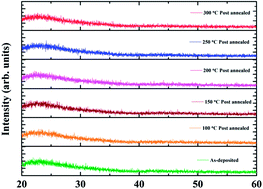Effects of post-annealing temperature on carbon incorporated amorphous indium–zinc-oxide thin-film transistors fabrication using sputtering at room temperature
Abstract
Amorphous carbon-incorporated indium zinc oxide (a-CIZO) thin-film transistors (TFTs) were fabricated at room temperature using radio frequency sputtering and post-annealing. The structural, surface, and optical properties were studied of the as-deposited and the post-annealed a-CIZO thin-films. X-ray diffraction and high-resolution transmission electron microscopy analysis confirmed the amorphous nature of the as-deposited and post-annealed a-CIZO thin-films. The root mean square roughness was measured ranging between 0.5 to 0.8 nm for the as-deposited and post-annealed a-CIZO thin films. The average transmittance ranging between 400 and 800 nm was observed for over 85% of the as-deposited and post-annealed a-CIZO thin-films. The estimated band gap varied in the range between 3.88 and 3.99 eV after post-annealing. The a-CIZO TFT post-annealed at 150 °C exhibited a saturation field-effect-mobility of 16.6 cm2 V−1 s−1, on/off current ratio of 107, subthreshold swing of 0.68 V per decade, and negligible hysteresis (0.4 V). The effects of the post-annealing temperature improved the performance of the a-CIZO TFTs.


 Please wait while we load your content...
Please wait while we load your content...